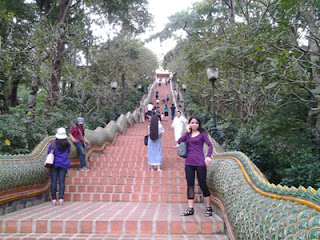The International Horticultural Exhibition near Chiang Mai is well worth a visit if you have an interest in tropical gardens and landscape design.
The exhibition site is about 30 minutes drive from Chiang Mai. The best way to get there is to either rent a car or bike or take a songthaew or taxi. If you do get a taxi then agree a price for the return journey and only pay after the return leg. As of March 2013 the taxi fare is 400 to 500 Thai Baht. To arrange the driver to pick you up when you are ready to go back to Chiang Mai take the driver’s telephone number.
The horticultural centre is one of Thailand's premier attractions, although hardly any one goes now that the 2011 event is over. The actual expo is held in a different international location every year. Despite this the Thai authorities have chosen to maintain the gardens and infrastructure. And it is great that they have.
Entry is 200 Thai Baht for foreigners, 100 Thai Baht for Thais, with 50% discount for over 60s, under 16s and students. ID proof is required for discounts.
The area is vast and being Thailand, it is hot. The best way to see the exhibition is to travel around by small trains on wheels. Trains ply the routes around the exhibition all day long. You don’t have to wait more than 10 minutes for a train. It is a very good set-up especially convenient for disabled and elderly people.
A major part of the exhibition was a display of gardens from around the world. These have been lovingly maintained and form the main attraction in the park. It is an impressively large area to explore – and the landscaping is not just inside the park area, but around it and on the approach road.
The main attraction is a Thai Temple that was built with an ornamental garden. Also of interest are several greenhouses. The collection of South East Asian plants is extensive and probably the best in the world. The variety of jungle plants runs into tens of thousands.
If you are after ideas for tropical gardens this is the place to come. Sculpture and ornaments are mixed with the landscaping. The topiary (hedge and shrub trimming) is particularly impressive – there is a wide range of trees, bushes and shrubs shaped into animals and geometric shapes. The bougainvillea plants are particularly spectacular.
If you have any interest in gardening and you are in the Chiang Mai area it is well worth paying a visit to the International Horticultural Exhibition.







